Abstract
Mild to moderate lead toxicity (blood lead, 25-55 micrograms/dl) is a preventable pediatric illness affecting several million preschool children ("lead-toxic children") in the United States. In-hospital lead-chelation treatment is predicated upon a positive CaNa2EDTA test, which is difficult to perform and impractical in large populations. After the development of an L-line x-ray fluorescence technique (LXRF) that measures cortical bone lead content safely, rapidly, and noninvasively, this study was initiated in lead-toxic children to compare LXRF with the CaNa2EDTA test. Moreover, LXRF provided the opportunity to quantify bone lead content. From blood lead and LXRF alone, 90% of lead-toxic children were correctly classified as being CaNa2EDTA-positive or -negative. In 76% of 59 lead-toxic children, bone lead values measured by LXRF were equal to or greater than those measured in normal and industrially exposed adults. These results indicate that LXRF may be capable of replacing the CaNa2EDTA test. When considered with the known neurotoxic effects on children of "low levels" of exposure to lead, these results also suggest that either an excessively narrow margin of safety or insufficient safety is provided by present U.S. guidelines, which classify an elevated blood lead concentration as 25 micrograms/dl or greater.
Full text
PDF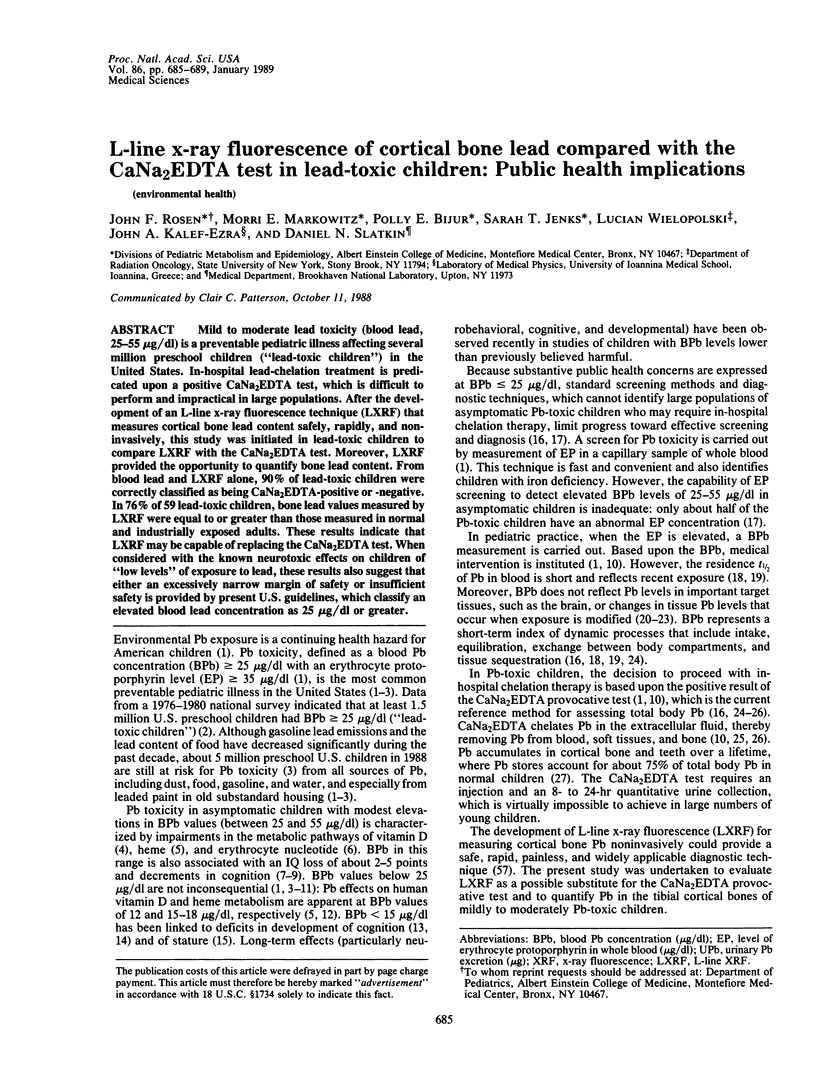
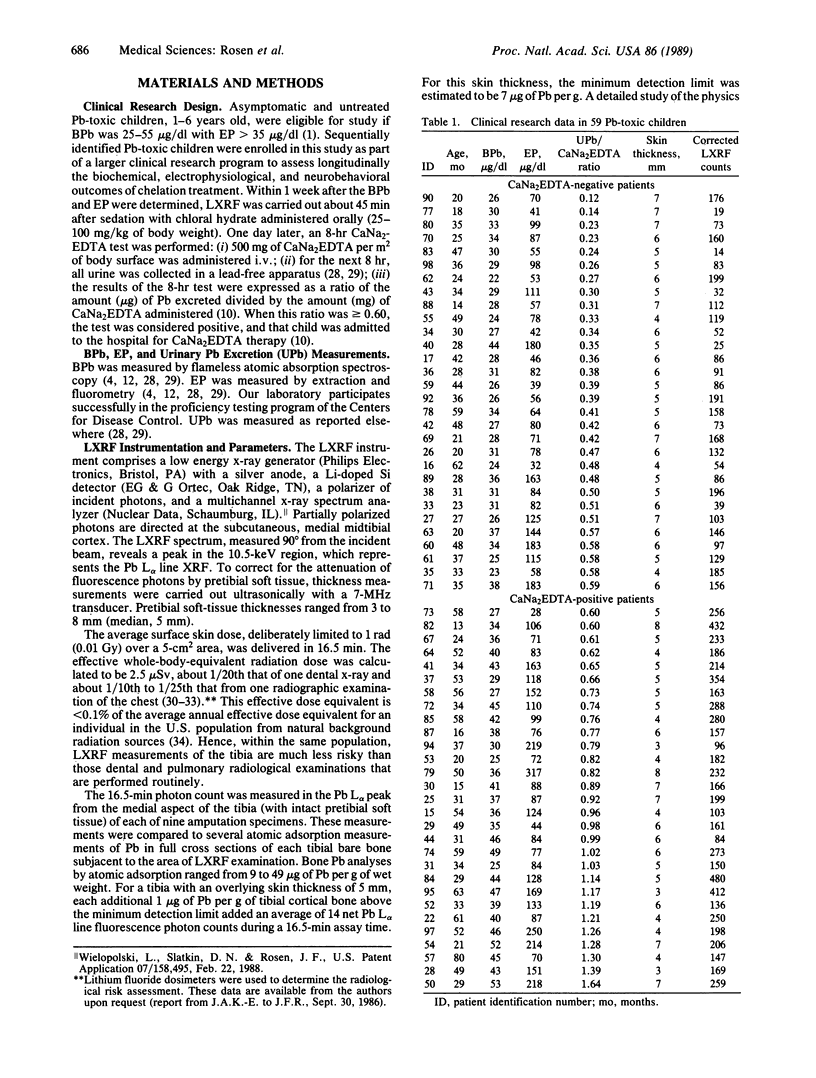
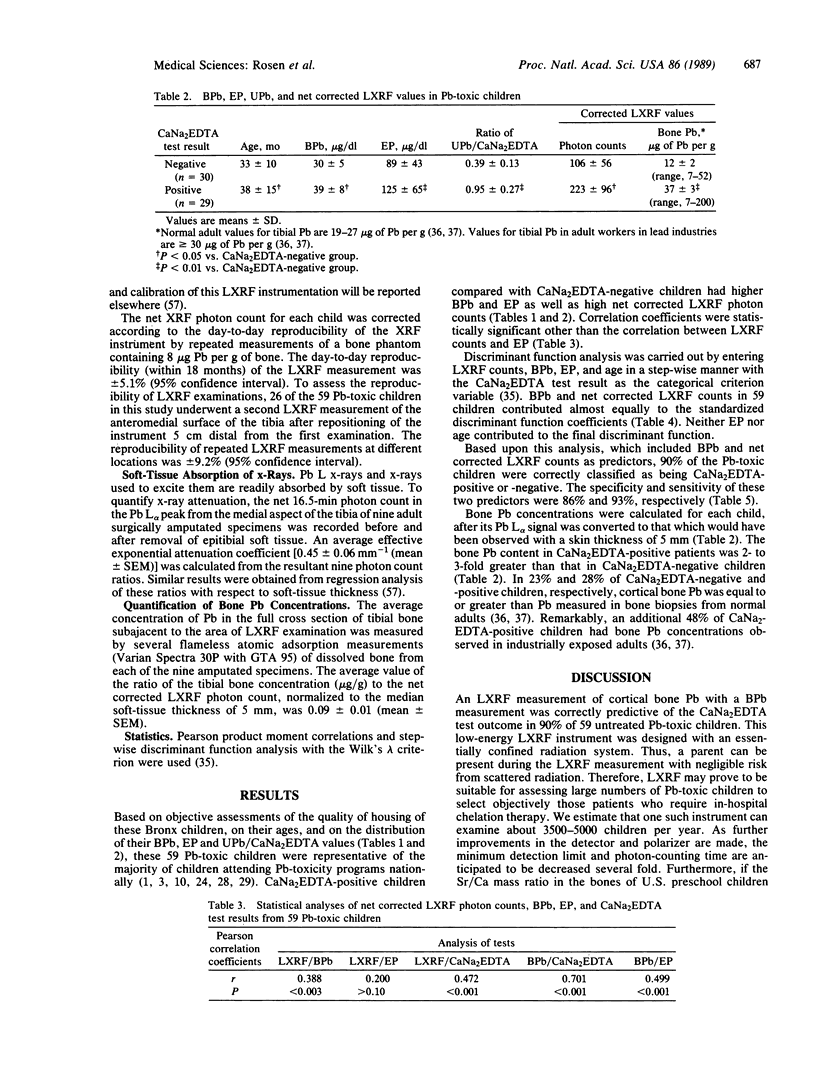
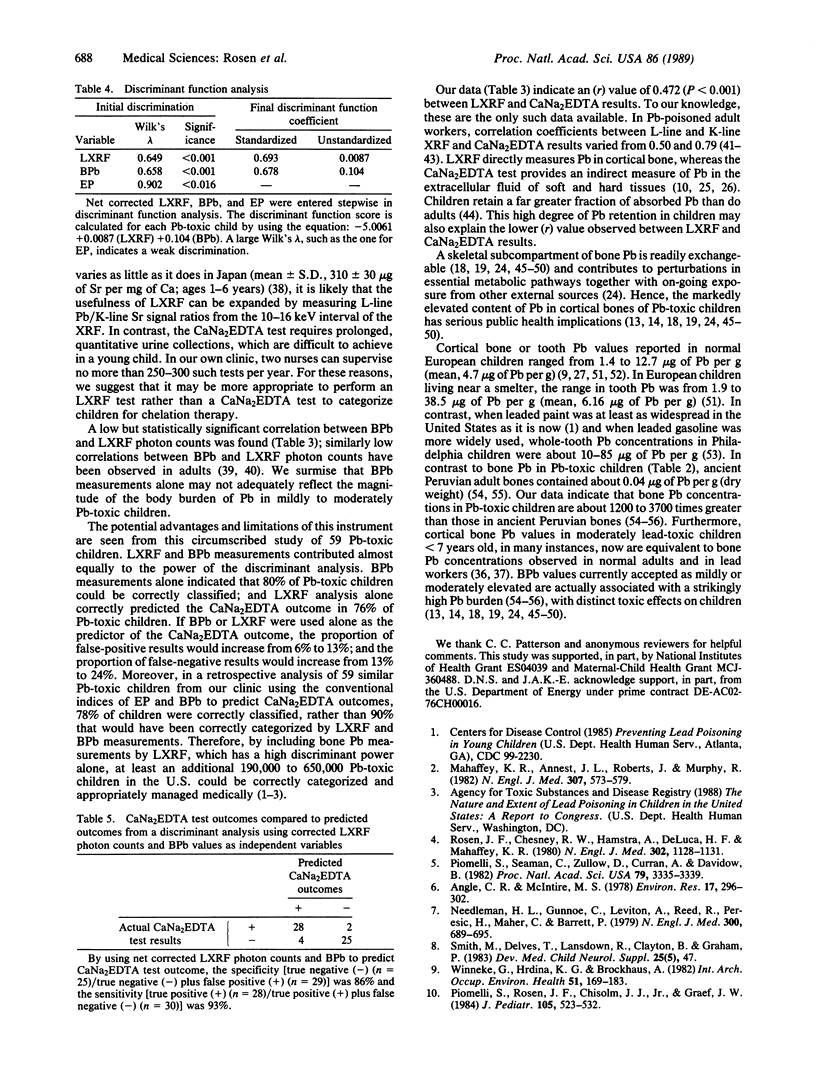
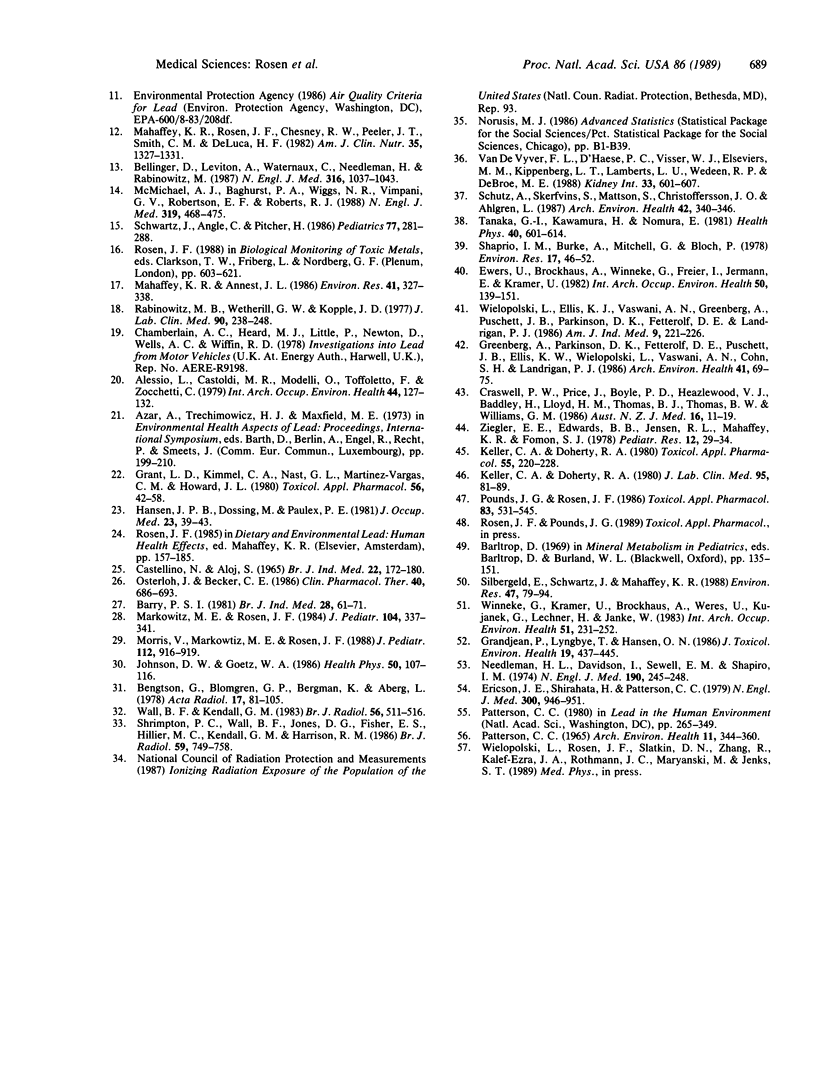
Selected References
These references are in PubMed. This may not be the complete list of references from this article.
- Alessio L., Castoldi M. R., Monelli O., Toffoletto F., Zocchetti C. Indicators of internal dose in current and past exposure to lead. Int Arch Occup Environ Health. 1979 Sep;44(2):127–132. doi: 10.1007/BF00386746. [DOI] [PubMed] [Google Scholar]
- Angle C. R., McIntire M. S. Low level lead and inhibition of erythrocyte pyrimidine nucleotidase. Environ Res. 1978 Oct;17(2):296–302. doi: 10.1016/0013-9351(78)90032-4. [DOI] [PubMed] [Google Scholar]
- Barry P. S. Concentrations of lead in the tissues of children. Br J Ind Med. 1981 Feb;38(1):61–71. doi: 10.1136/oem.38.1.61. [DOI] [PMC free article] [PubMed] [Google Scholar]
- Bellinger D., Leviton A., Waternaux C., Needleman H., Rabinowitz M. Longitudinal analyses of prenatal and postnatal lead exposure and early cognitive development. N Engl J Med. 1987 Apr 23;316(17):1037–1043. doi: 10.1056/NEJM198704233161701. [DOI] [PubMed] [Google Scholar]
- Bengtsson G., Blomgren P. G., Bergman K., Aberg L. Patient exposures and radiation risks in Swedish diagnostic radiology. Acta Radiol Oncol Radiat Phys Biol. 1978;17(2):81–105. doi: 10.3109/02841867809127910. [DOI] [PubMed] [Google Scholar]
- Craswell P. W., Price J., Boyle P. D., Heazlewood V. J., Baddeley H., Lloyd H. M., Thomas B. J., Thomas B. W., Williams G. M. Chronic lead nephropathy in Queensland: alternative methods of diagnosis. Aust N Z J Med. 1986 Feb;16(1):11–19. doi: 10.1111/j.1445-5994.1986.tb01107.x. [DOI] [PubMed] [Google Scholar]
- Ericson J. E., Shirahata H., Patterson C. C. Skeletal concentrations of lead in ancient Peruvians. N Engl J Med. 1979 Apr 26;300(17):946–951. doi: 10.1056/NEJM197904263001703. [DOI] [PubMed] [Google Scholar]
- Ewers U., Brockhaus A., Winneke G., Freier I., Jermann E., Krämer U. Lead in deciduous teeth of children living in a non-ferrous smelter area and a rural area of the FRG. Int Arch Occup Environ Health. 1982;50(2):139–151. doi: 10.1007/BF00378076. [DOI] [PubMed] [Google Scholar]
- Grandjean P., Lyngbye T., Hansen O. N. Lead concentration in deciduous teeth: variation related to tooth type and analytical technique. J Toxicol Environ Health. 1986;19(3):437–444. doi: 10.1080/15287398609530941. [DOI] [PubMed] [Google Scholar]
- Grant L. D., Kimmel C. A., West G. L., Martinez-Vargas C. M., Howard J. L. Chronic low-level lead toxicity in the rat. II. Effects on postnatal physical and behavioral development. Toxicol Appl Pharmacol. 1980 Oct;56(1):42–58. doi: 10.1016/0041-008x(80)90130-1. [DOI] [PubMed] [Google Scholar]
- Greenberg A., Parkinson D. K., Fetterolf D. E., Puschett J. B., Ellis K. J., Wielopolski L., Vaswani A. N., Cohn S. H., Landrigan P. J. Effects of elevated lead and cadmium burdens on renal function and calcium metabolism. Arch Environ Health. 1986 Mar-Apr;41(2):69–76. doi: 10.1080/00039896.1986.9937412. [DOI] [PubMed] [Google Scholar]
- Hansen J. P., Døssing M., Paulev P. E. Chelatable lead body burden (by calcium-disodium EDTA) and blood lead concentration in man. J Occup Med. 1981 Jan;23(1):39–43. doi: 10.1097/00043764-198101000-00017. [DOI] [PubMed] [Google Scholar]
- Johnson D. W., Goetz W. A. Patient exposure trends in medical and dental radiography. Health Phys. 1986 Jan;50(1):107–116. [PubMed] [Google Scholar]
- Keller C. A., Doherty R. A. Bone lead mobilization in lactating mice and lead transfer to suckling offspring. Toxicol Appl Pharmacol. 1980 Sep 15;55(2):220–228. doi: 10.1016/0041-008x(80)90083-6. [DOI] [PubMed] [Google Scholar]
- Keller C. A., Doherty R. A. Lead and calcium distributions in blood, plasma and milk of the lactating mouse. J Lab Clin Med. 1980 Jan;95(1):81–89. [PubMed] [Google Scholar]
- Mahaffey K. R., Annest J. L. Association of erythrocyte protoporphyrin with blood lead level and iron status in the second National Health and Nutrition Examination Survey, 1976-1980. Environ Res. 1986 Oct;41(1):327–338. doi: 10.1016/s0013-9351(86)80194-3. [DOI] [PubMed] [Google Scholar]
- Mahaffey K. R., Annest J. L., Roberts J., Murphy R. S. National estimates of blood lead levels: United States, 1976-1980: association with selected demographic and socioeconomic factors. N Engl J Med. 1982 Sep 2;307(10):573–579. doi: 10.1056/NEJM198209023071001. [DOI] [PubMed] [Google Scholar]
- Mahaffey K. R., Rosen J. F., Chesney R. W., Peeler J. T., Smith C. M., DeLuca H. F. Association between age, blood lead concentration, and serum 1,25-dihydroxycholecalciferol levels in children. Am J Clin Nutr. 1982 Jun;35(6):1327–1331. doi: 10.1093/ajcn/35.6.1327. [DOI] [PubMed] [Google Scholar]
- Markowitz M. E., Rosen J. F. Assessment of lead stores in children: validation of an 8-hour CaNa2EDTA provocative test. J Pediatr. 1984 Mar;104(3):337–341. doi: 10.1016/s0022-3476(84)81091-4. [DOI] [PubMed] [Google Scholar]
- McMichael A. J., Baghurst P. A., Wigg N. R., Vimpani G. V., Robertson E. F., Roberts R. J. Port Pirie Cohort Study: environmental exposure to lead and children's abilities at the age of four years. N Engl J Med. 1988 Aug 25;319(8):468–475. doi: 10.1056/NEJM198808253190803. [DOI] [PubMed] [Google Scholar]
- Morris V., Markowitz M. E., Rosen J. F. Serial measurements of aminolevulinic acid dehydratase in children with lead toxicity. J Pediatr. 1988 Jun;112(6):916–919. doi: 10.1016/s0022-3476(88)80216-6. [DOI] [PubMed] [Google Scholar]
- Needleman H. L., Davidson I., Sewell E. M., Shapiro I. M. Subclinical lead exposure in philadelphia schoolchildren. Identification by dentine lead analysis. N Engl J Med. 1974 Jan 31;290(5):245–248. doi: 10.1056/NEJM197401312900504. [DOI] [PubMed] [Google Scholar]
- Needleman H. L., Gunnoe C., Leviton A., Reed R., Peresie H., Maher C., Barrett P. Deficits in psychologic and classroom performance of children with elevated dentine lead levels. N Engl J Med. 1979 Mar 29;300(13):689–695. doi: 10.1056/NEJM197903293001301. [DOI] [PubMed] [Google Scholar]
- Osterloh J., Becker C. E. Pharmacokinetics of CaNa2EDTA and chelation of lead in renal failure. Clin Pharmacol Ther. 1986 Dec;40(6):686–693. doi: 10.1038/clpt.1986.245. [DOI] [PubMed] [Google Scholar]
- PATTERSON C. C. CONTAMINATED AND NATURAL LEAD ENVIRONMENTS OF MAN. Arch Environ Health. 1965 Sep;11:344–360. doi: 10.1080/00039896.1965.10664229. [DOI] [PubMed] [Google Scholar]
- Piomelli S., Rosen J. F., Chisolm J. J., Jr, Graef J. W. Management of childhood lead poisoning. J Pediatr. 1984 Oct;105(4):523–532. doi: 10.1016/s0022-3476(84)80414-x. [DOI] [PubMed] [Google Scholar]
- Piomelli S., Seaman C., Zullow D., Curran A., Davidow B. Threshold for lead damage to heme synthesis in urban children. Proc Natl Acad Sci U S A. 1982 May;79(10):3335–3339. doi: 10.1073/pnas.79.10.3335. [DOI] [PMC free article] [PubMed] [Google Scholar]
- Pounds J. G., Rosen J. F. Cellular metabolism of lead: a kinetic analysis in cultured osteoclastic bone cells. Toxicol Appl Pharmacol. 1986 May;83(3):531–545. doi: 10.1016/0041-008x(86)90236-x. [DOI] [PubMed] [Google Scholar]
- Rabinowitz M. B., Wetherill G. W., Kopple J. D. Magnitude of lead intake from respiration by normal man. J Lab Clin Med. 1977 Aug;90(2):238–248. [PubMed] [Google Scholar]
- Rosen J. F., Chesney R. W., Hamstra A., DeLuca H. F., Mahaffey K. R. Reduction in 1,25-dihydroxyvitamin D in children with increased lead absorption. N Engl J Med. 1980 May 15;302(20):1128–1131. doi: 10.1056/NEJM198005153022006. [DOI] [PubMed] [Google Scholar]
- Schwartz J., Angle C., Pitcher H. Relationship between childhood blood lead levels and stature. Pediatrics. 1986 Mar;77(3):281–288. [PubMed] [Google Scholar]
- Schütz A., Skerfving S., Christoffersson J. O., Ahlgren L., Mattson S. Lead in vertebral bone biopsies from active and retired lead workers. Arch Environ Health. 1987 Nov-Dec;42(6):340–346. doi: 10.1080/00039896.1987.9934356. [DOI] [PubMed] [Google Scholar]
- Shapiro I. M., Burke A., Mitchell G., Bloch P. X-ray fluorescence analysis of lead in teeth of urban children in situ: correlation between the tooth lead level and the concentration of blood lead and free erythroporphyrins. Environ Res. 1978 Aug;17(1):46–52. doi: 10.1016/0013-9351(78)90059-2. [DOI] [PubMed] [Google Scholar]
- Shrimpton P. C., Wall B. F., Jones D. G., Fisher E. S., Hillier M. C., Kendall G. M., Harrison R. M. Doses to patients from routine diagnostic X-ray examinations in England. Br J Radiol. 1986 Aug;59(704):749–758. doi: 10.1259/0007-1285-59-704-749. [DOI] [PubMed] [Google Scholar]
- Silbergeld E. K., Schwartz J., Mahaffey K. Lead and osteoporosis: mobilization of lead from bone in postmenopausal women. Environ Res. 1988 Oct;47(1):79–94. doi: 10.1016/s0013-9351(88)80023-9. [DOI] [PubMed] [Google Scholar]
- Tanaka G., Kawamura H., Nomura E. Reference Japanese man--II. Distribution of strontium in the skeleton and in the mass of mineralized bone. Health Phys. 1981 May;40(5):601–614. doi: 10.1097/00004032-198105000-00001. [DOI] [PubMed] [Google Scholar]
- Van de Vyver F. L., D'Haese P. C., Visser W. J., Elseviers M. M., Knippenberg L. J., Lamberts L. V., Wedeen R. P., De Broe M. E. Bone lead in dialysis patients. Kidney Int. 1988 Feb;33(2):601–607. doi: 10.1038/ki.1988.39. [DOI] [PubMed] [Google Scholar]
- Wall B. F., Kendall G. M. Collective doses and risks from dental radiology in Great Britain. Br J Radiol. 1983 Aug;56(668):511–516. doi: 10.1259/0007-1285-56-668-511. [DOI] [PubMed] [Google Scholar]
- Wielopolski L., Ellis K. J., Vaswani A. N., Cohn S. H., Greenberg A., Puschett J. B., Parkinson D. K., Fetterolf D. E., Landrigan P. J. In vivo bone lead measurements: a rapid monitoring method for cumulative lead exposure. Am J Ind Med. 1986;9(3):221–226. doi: 10.1002/ajim.4700090304. [DOI] [PubMed] [Google Scholar]
- Winneke G., Hrdina K. G., Brockhaus A. Neuropsychological studies in children with elevated tooth-lead concentrations. I. Pilot study. Int Arch Occup Environ Health. 1982;51(2):169–183. doi: 10.1007/BF00378161. [DOI] [PubMed] [Google Scholar]
- Winneke G., Krämer U., Brockhaus A., Ewers U., Kujanek G., Lechner H., Janke W. Neuropsychological studies in children with elevated tooth-lead concentrations. II. Extended study. Int Arch Occup Environ Health. 1983;51(3):231–252. doi: 10.1007/BF00377755. [DOI] [PubMed] [Google Scholar]
- Ziegler E. E., Edwards B. B., Jensen R. L., Mahaffey K. R., Fomon S. J. Absorption and retention of lead by infants. Pediatr Res. 1978 Jan;12(1):29–34. doi: 10.1203/00006450-197801000-00008. [DOI] [PubMed] [Google Scholar]


